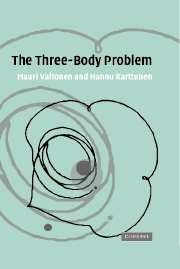Book contents
- Frontmatter
- Contents
- Preface
- 1 Astrophysics and the three-body problem
- 2 Newtonian mechanics
- 3 The two-body problem
- 4 Hamiltonian mechanics
- 5 The planar restricted circular three-body problem and other special cases
- 6 Three-body scattering
- 7 Escape in the general three-body problem
- 8 Scattering and capture in the general problem
- 9 Perturbations in hierarchical systems
- 10 Perturbations in strong three-body encounters
- 11 Some astrophysical problems
- References
- Author index
- Subject index
6 - Three-body scattering
Published online by Cambridge University Press: 04 December 2009
- Frontmatter
- Contents
- Preface
- 1 Astrophysics and the three-body problem
- 2 Newtonian mechanics
- 3 The two-body problem
- 4 Hamiltonian mechanics
- 5 The planar restricted circular three-body problem and other special cases
- 6 Three-body scattering
- 7 Escape in the general three-body problem
- 8 Scattering and capture in the general problem
- 9 Perturbations in hierarchical systems
- 10 Perturbations in strong three-body encounters
- 11 Some astrophysical problems
- References
- Author index
- Subject index
Summary
Three-body systems tend to be unstable. Often they are only short-lived stages in the evolution of a dynamical system. Typically a body comes from a large distance, meets a binary, and escapes again far away. The meeting could be a distant flyby or a close encounter with one of the binary members. Both types of events are important and will be studied in turn. Here we will study only the latter situation, and limit ourselves to the case where the third body is of low mass in comparison with the binary. The general scattering problem is left to Chapters 8 and 10. As in the two-body problem, the transfer of the third body from one hyperbolic relative orbit to another is called scattering.
Scattering of small fast bodies from a binary
The restricted circular three-body problem deals with the motion of a ‘massless’ body in the gravitational field of a zero eccentricity binary. What we will now discuss is a similar problem, namely the motion of a low mass body in the binary field. In our problem the low mass body arrives from a large distance with a high speed, scatters from the binary and flies away. The problem is similar to the twobody scattering of Section 3.13.We present the discussion of three-body scattering following Gould (1991).
- Type
- Chapter
- Information
- The Three-Body Problem , pp. 141 - 170Publisher: Cambridge University PressPrint publication year: 2006



